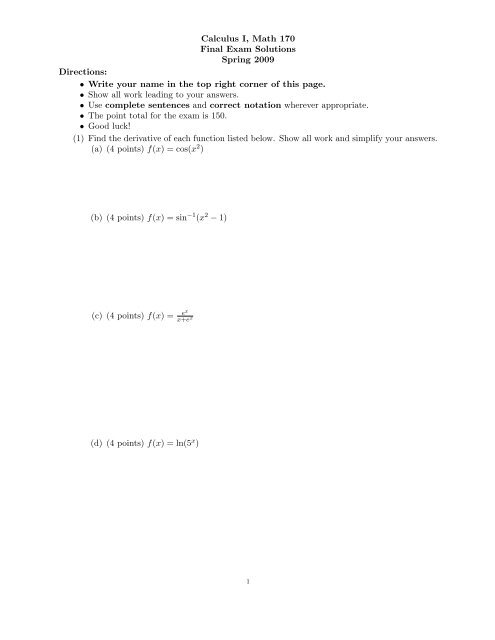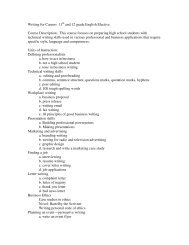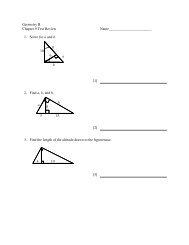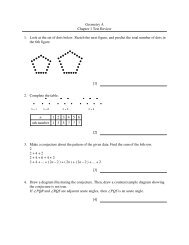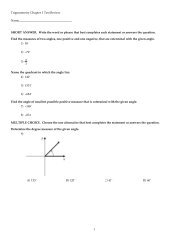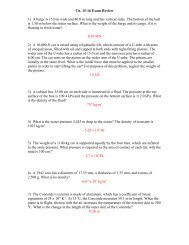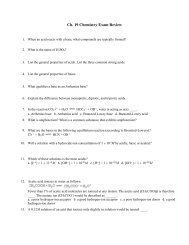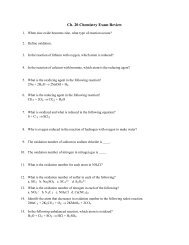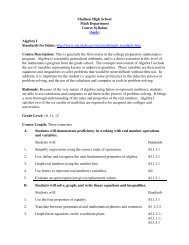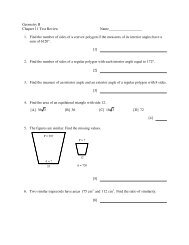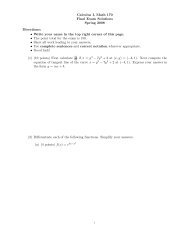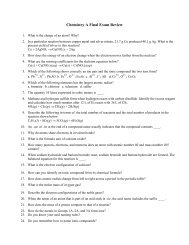Calculus I, Math 170 Final Exam Solutions Spring 2009 Directions ...
Calculus I, Math 170 Final Exam Solutions Spring 2009 Directions ...
Calculus I, Math 170 Final Exam Solutions Spring 2009 Directions ...
Create successful ePaper yourself
Turn your PDF publications into a flip-book with our unique Google optimized e-Paper software.
<strong>Calculus</strong> I, <strong>Math</strong> <strong>170</strong><br />
<strong>Final</strong> <strong>Exam</strong> <strong>Solutions</strong><br />
<strong>Spring</strong> <strong>2009</strong><br />
<strong>Directions</strong>:<br />
• Write your name in the top right corner of this page.<br />
• Show all work leading to your answers.<br />
• Use complete sentences and correct notation wherever appropriate.<br />
• The point total for the exam is 150.<br />
• Good luck!<br />
(1) Find the derivative of each function listed below. Show all work and simplify your answers.<br />
(a) (4 points) f(x) = cos(x2 )<br />
(b) (4 points) f(x) = sin −1 (x 2 − 1)<br />
(c) (4 points) f(x) = ex<br />
x+e x<br />
(d) (4 points) f(x) = ln(5 x )<br />
1
(2) Find each of the limits given below. Work is required to justify each of your answers. If<br />
the limit does not exist, then state why.<br />
√<br />
x − 1 − 2<br />
(a) (4 points) lim<br />
x→5 x − 5<br />
sin x<br />
(b) (4 points) lim<br />
x→∞ x<br />
(c) (4 points) lim<br />
x→0<br />
csc 2x<br />
cot x
16<br />
14<br />
(3) A particle moves along the12y-axis. Its initial position at t = 0 sec is y(0) = 3 cm. The figure<br />
below shows the graph of the particle’s velocity v(t); the numbers shown are the signed<br />
areas of the enclosed regions. (cm/sec) v<br />
Show Text Objects<br />
Show Function Plot<br />
Show Points<br />
10<br />
8<br />
6<br />
4<br />
2<br />
-5 5 10t<br />
-2<br />
17<br />
-8 2 (sec)<br />
-4<br />
-6<br />
-8<br />
-10<br />
(a) (3 points) What is the particle’s displacement between t = 0 sec and t = 6 sec?<br />
-12<br />
-14<br />
(b) (3 points) Give the position -16 of the particle at t = 2 sec, t = 6 sec, and t = 10 sec.<br />
-18<br />
(c) (4 points) What is the total distance traveled by the particle on the time interval<br />
[0, 10]?<br />
(d) (2 points) Approximately when does the particle achieve its greatest downward acceleration<br />
on the interval [0, 10]?
(e) (2 points) Approximately when does the particle achieve its greatest upward acceleration<br />
on the interval [2, 10]?<br />
(4) (8 points) Use the method of logarithmic differentiation to calculate y ′ where y = x sin x .<br />
(5) (6 points) For the equation y 2 − x cos y = 5, find dy<br />
dx<br />
by implicit differentiation.<br />
(6) (6 points) Determine the point(s) (x, y), if any, on the graph of y = x + ln x where the<br />
tangent line(s) is perpendicular to the line l given by 2x + 6y = 5.
(7) An iron works company has contracted with a paper company to design and build a 500 ft 3<br />
steel rectangular holding tank with a square base and open top. The tank is to be made by<br />
welding thin stainless steel plates together along their edges. As the production engineer,<br />
your job is to find the dimensions for the base and height that will make the tank weigh as<br />
little as possible.<br />
(a) (2 points) What measurement relates to the weight of the tank?<br />
(b) (8 points) What dimensions do you tell the shop to use?<br />
(8) Find the indefinite or definite integrals of each of the following:<br />
<br />
x3 − 3x2 + 5<br />
(a) (8 points)<br />
dx<br />
x − 3
π/2 cos x<br />
(b) (8 points) √ dx;<br />
0 4 + 3 sin x<br />
(9) A company which conducts telephone polls estimates that for a certain survey, the number<br />
of minutes required by an employee to complete the k th interview is given by the function<br />
f(k) = 4(1 + k) −1/5 .<br />
(a) (6 points) Use a definite integral to estimate the amount of time required for an employee<br />
to complete 100 interviews and 200 interviews.<br />
(b) (6 points) If employees are paid $7.20 per hour, find the cost differential of one employee<br />
conducting 200 interviews versus 2 employees conducting 100 interviews each. If the<br />
objective is to save on costs, what should the company do?
(10) Consider the region R bounded by the x-axis, the line x = 4 and the curve y = √ f( x)<br />
= x<br />
8<br />
x. Find<br />
the volumes of the solids when<br />
(a) (6 points) R is rotated about the x-axis,<br />
(b) (6 points) R is rotated about the line6x = 4.<br />
10<br />
4<br />
2<br />
-10 -5 5 10 R(4,<br />
2)<br />
S<br />
-2<br />
-4<br />
-6<br />
-8<br />
-10<br />
-12<br />
-14
(11) The figure given below is a slope field of the differential equation dy<br />
8<br />
x<br />
= . The point<br />
dx y<br />
R = (1, 0).<br />
(a) (2 points) On the figure, sketch an approximate solution to the differential equation<br />
6<br />
that passes through the point R.<br />
-8 -6 -4 -2 2 4 6<br />
Show Point Q<br />
4<br />
2<br />
-2<br />
-4<br />
-6<br />
xR = 0.50 SlopeAtR = ∞<br />
Direction<br />
(b) (8 points) Find the solution -8<br />
Move R -> Q<br />
yR = 0.00 y = f(x) to the differential equation that passes through<br />
h = 0.20<br />
R, i.e., dy<br />
dx<br />
= x<br />
y<br />
, y(2) = −1.<br />
Hide Segment<br />
-10<br />
-12<br />
-14<br />
R<br />
Show Grid Controls<br />
Show Initial Pt
(12) Let f(x) = x2 − 4. By completing each step listed below, you will have proved that<br />
lim f(x) = 5 by verifying the precise definition of limit.<br />
x→3<br />
(a) (4 points) Argue by elementary means that<br />
|f(x) − 5|<br />
|x − 3|<br />
≤ 7 for 2 ≤ x ≤ 4, x = 3.<br />
(b) (4 points) Use part a to show that |f(x) − 5| ≤ 7|x − 3| when 2 ≤ x ≤ 4, x = 3.<br />
(c) (4 points) Given ɛ > 0, show that if 0 < δ < min(ɛ/7, 1), i.e. δ is chosen to be less<br />
than the minimum of ɛ/7 and 1, then<br />
0 < |x − 3| < δ =⇒ |f(x) − 5| < ɛ
(13) Car A is traveling due west toward school at a speed of 55 mph. Car B is traveling due<br />
north away from school at a speed of 40 mph. Let x be the distance between Car A and<br />
the school at time t, and let y be the distance between Car B and the school at time t, as<br />
shown in the figure.<br />
y B<br />
(a) (2 points) Find the distance in miles between the cars when x = 20 miles and y = 15<br />
miles. A school d x<br />
(b) (8 points) Find the rate of change, in mph, of the distance between the two cars when<br />
x = 20 miles and y = 15 miles.<br />
(c) (6 points) Let θ be the angle at Car A in the above figure. Find θ ′ , the rate of change<br />
of θ with respect to time when x = 20 and y = 15. Based upon your answer, is θ<br />
increasing?


